The Kaveri Refresh 'Godavari' Review: Testing AMD's A10-7870K
by Ian Cutress on June 1, 2015 11:59 AM ESTGaming Benchmarks: Low End
Alien: Isolation
If first person survival mixed with horror is your sort of thing, then Alien: Isolation, based off of the Alien franchise, should be an interesting title. Developed by The Creative Assembly and released in October 2014, Alien: Isolation has won numerous awards from Game Of The Year to several top 10s/25s and Best Horror titles, ratcheting up over a million sales by February 2015. Alien: Isolation uses a custom built engine which includes dynamic sound effects and should be fully multi-core enabled.
For low end graphics, we test at 720p with Ultra settings, whereas for mid and high range graphics we bump this up to 1080p, taking the average frame rate as our marker with a scripted version of the built-in benchmark.
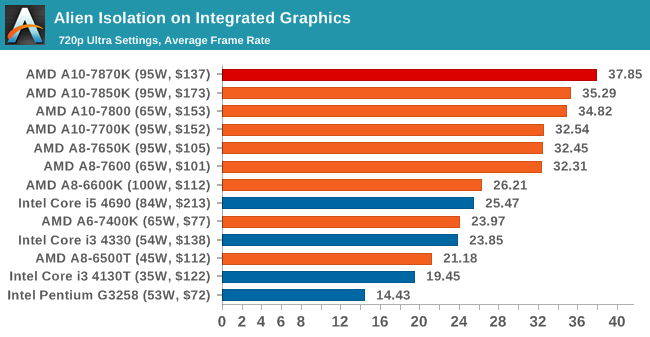
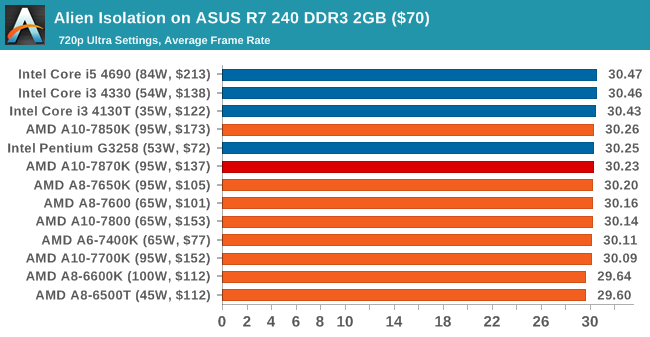
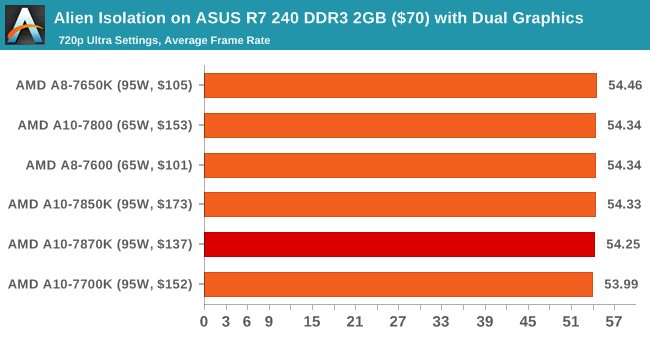
Total War: Attila
The Total War franchise moves on to Attila, another The Creative Assembly development, and is a stand-alone strategy title set in 395AD where the main story line lets the gamer take control of the leader of the Huns in order to conquer parts of the world. Graphically the game can render hundreds/thousands of units on screen at once, all with their individual actions and can put some of the big cards to task.
For low end graphics, we test at 720p with performance settings, recording the average frame rate. With mid and high range graphics, we test at 1080p with the quality setting. In both circumstances, unlimited video memory is enabled and the in-game scripted benchmark is used.
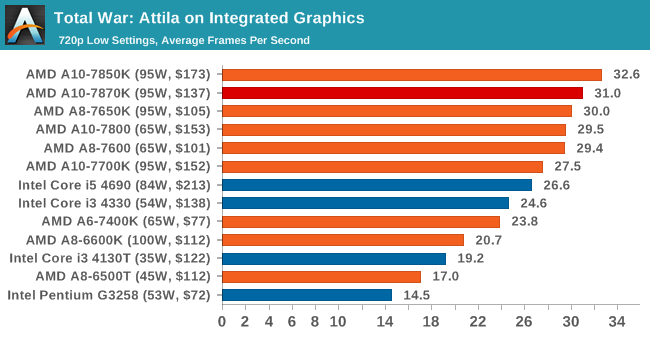
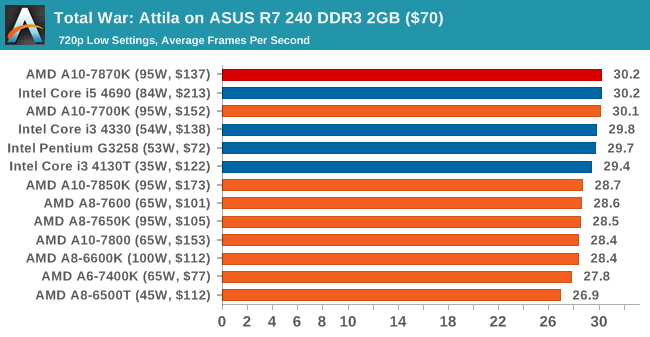
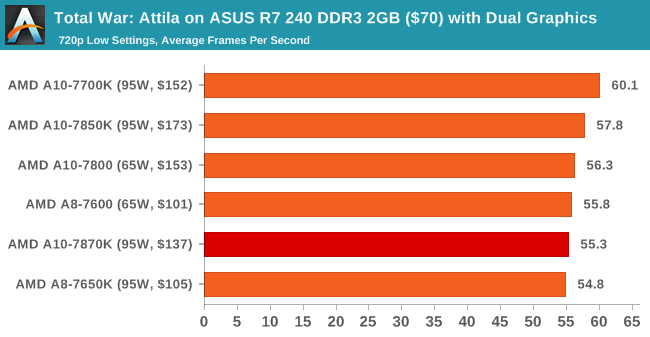
Grand Theft Auto V
The highly anticipated iteration of the Grand Theft Auto franchise finally hit the shelves on April 14th 2015, with both AMD and NVIDIA in tow to help optimize the title. GTA doesn’t provide graphical presets, but opens up the options to users and extends the boundaries by pushing even the hardest systems to the limit using Rockstar’s Advanced Game Engine. Whether the user is flying high in the mountains with long draw distances or dealing with assorted trash in the city, when cranked up to maximum it creates stunning visuals but hard work for both the CPU and the GPU.
For our test we have scripted a version of the in-game benchmark, relying only on the final part which combines a flight scene along with an in-city drive-by followed by a tanker explosion. For low end systems we test at 720p on the lowest settings, whereas mid and high end graphics play at 1080p with very high settings across the board. We record both the average frame rate and the percentage of frames under 60 FPS (16.6ms).
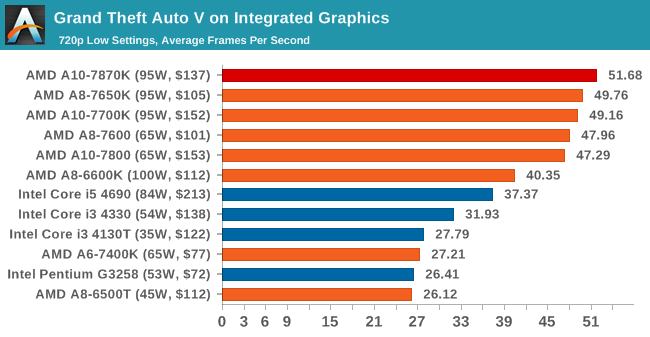
![Grand Theft Auto V on Integrated Graphics [Under 60 FPS]](https://images.anandtech.com/graphs/graph9307/74850.png)
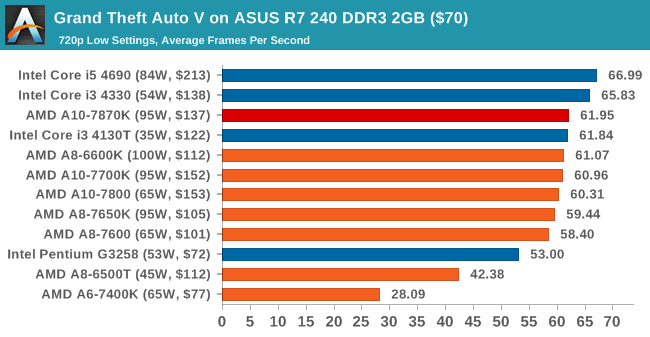
![Grand Theft Auto V on ASUS R7 240 DDR3 2GB ($70) [Under 60 FPS]](https://images.anandtech.com/graphs/graph9307/74858.png)
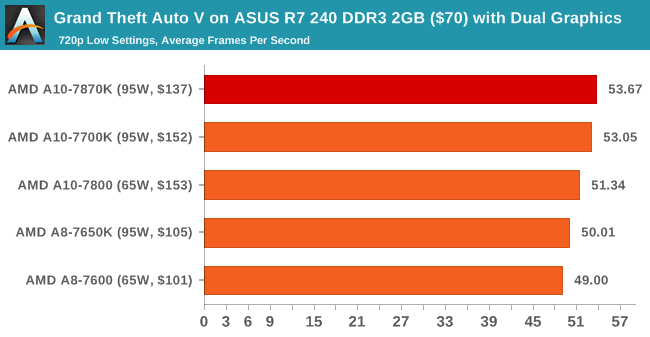
![Grand Theft Auto V on ASUS R7 240 DDR3 2GB ($70) with Dual Graphics [Under 60 FPS]](https://images.anandtech.com/graphs/graph9307/74866.png)
GRID: Autosport
No graphics tests are complete without some input from Codemasters and the EGO engine, which means for this round of testing we point towards GRID: Autosport, the next iteration in the GRID and racing genre. As with our previous racing testing, each update to the engine aims to add in effects, reflections, detail and realism, with Codemasters making ‘authenticity’ a main focal point for this version.
GRID’s benchmark mode is very flexible, and as a result we created a test race using a shortened version of the Red Bull Ring with twelve cars doing two laps. The car is focus starts last and is quite fast, but usually finishes second or third. For low end graphics we test at 1080p medium settings, whereas mid and high end graphics get the full 1080p maximum. Both the average and minimum frame rates are recorded.
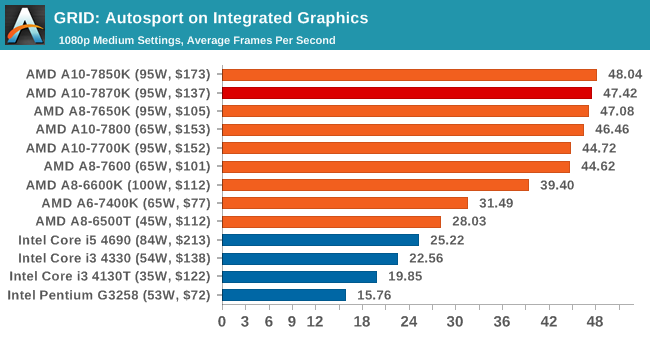
![GRID: Autosport on Integrated Graphics [Minimum FPS]](https://images.anandtech.com/graphs/graph9307/74852.png)
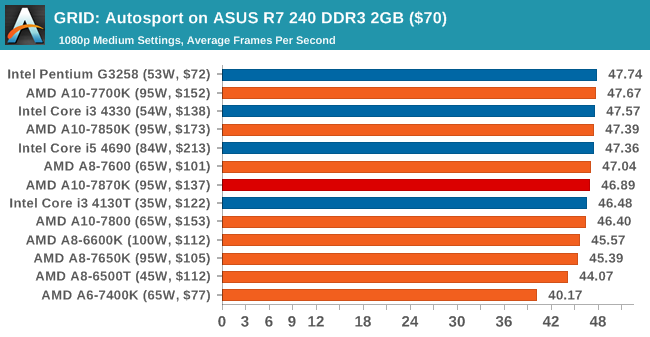
![GRID: Autosport on ASUS R7 240 DDR3 2GB ($70) [Minimum FPS]](https://images.anandtech.com/graphs/graph9307/74860.png)
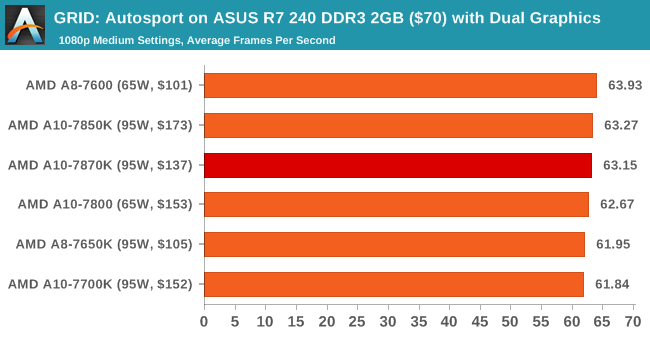
![GRID: Autosport on ASUS R7 240 DDR3 2GB ($70) with Dual Graphics [Minimum FPS]](https://images.anandtech.com/graphs/graph9307/74868.png)
Middle-Earth: Shadows of Mordor
The final title in our testing is another battle of system performance with the open world action-adventure title, Shadows of Mordor. Produced by Monolith using the LithTech Jupiter EX engine and numerous detail add-ons, SoM goes for detail and complexity to a large extent, despite having to be cut down from the original plans. The main story itself was written by the same writer as Red Dead Redemption, and it received Zero Punctuation’s Game of The Year in 2014.
For testing purposes, SoM gives a dynamic screen resolution setting, allowing us to render at high resolutions that are then scaled down to the monitor. As a result, we get several tests using the in-game benchmark. For low end graphics we examine at 720p with low settings, whereas mid and high end graphics get 1080p Ultra. The top graphics test is also redone at 3840x2160, also with Ultra settings, and we also test two cards at 4K where possible.
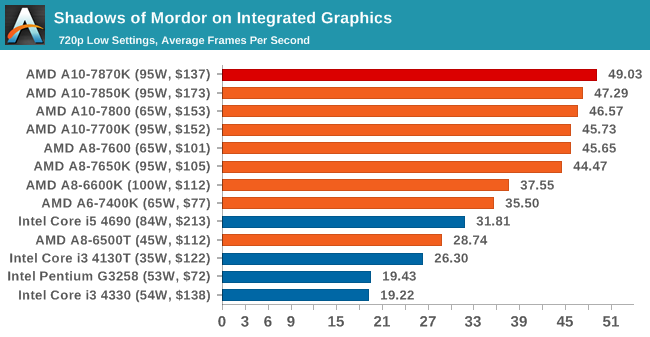
![Shadows of Mordor on Integrated Graphics [Minimum FPS]](https://images.anandtech.com/graphs/graph9307/74854.png)
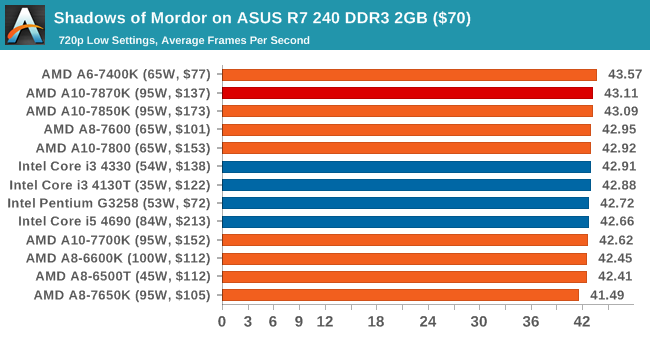
![Shadows of Mordor on ASUS R7 240 DDR3 2GB ($70) [Minimum FPS]](https://images.anandtech.com/graphs/graph9307/74862.png)
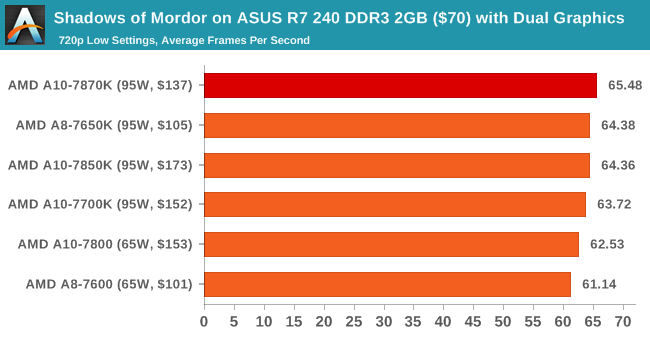
![Shadows of Mordor on ASUS R7 240 DDR3 2GB ($70) with Dual Graphics [Minimum FPS]](https://images.anandtech.com/graphs/graph9307/74870.png)
Conclusions on Low-End Graphics
While the extra 20% IGP frequency doesn’t translate into massive improvements in frame rates, almost every game saw a small bump in the performance, which is sometimes all you need to get a good 30/60 FPS average. Our dual graphics testing was influenced even less by the IGP frequency increase, but the A10-7870K does take the title of the fastest integrated graphics on the market with the benefit of being socketed.















140 Comments
View All Comments
Travis26 - Tuesday, June 2, 2015 - link
AMD seems to have the stock voltages too high a lot of times. My Athlon x4 750k with default settings goes up to 1.45 V for the 4 Ghz turbo boost, but it is perfectly stable at 1.29V and possibly lower. I had to lower the voltage because the temperatures were too high under load with the stock cooler.hallstein - Monday, June 1, 2015 - link
Something is seriously wrong with these numbers. The ordering of the AMD parts seems to be effectively random in many cases. What the hell happened?And the conclusions drawn make no reference to the crazy numbers. I'm a big fan of anandtech's reporting, but I'm sorry to say this article is just about useless as is.
number99 - Monday, June 1, 2015 - link
I agree. Part of the problem may be the need for a new bios for the new cpu (it seems to be throttling), but a lot of the benches don't make sense.silverblue - Tuesday, June 2, 2015 - link
The board in question isn't the same as the one that CPU World used (ASRock FM2A88M Extreme4+). Unless AMD made a large boo-boo pre-release that would affect multiple vendors' BIOS updates, I can't see this affecting the results too much. It may be worth testing on that ASRock board to see what a patched board will do, or perhaps throwing a 7850K into the MSI board to see if the board itself is to blame. It's likely the higher Kaveri models, but the power usage looks rather off as well so it could be the board.I'm waiting on another review which can hopefully shed some light on the performance issues we've been seeing. Perhaps it was really only AT's sample that was causing issues?
Vesperan - Monday, June 1, 2015 - link
I find it interesting that even with a R9 285 or GTX 770 you are quite often GPU bound (at 1080p) rather than CPU bound. If your only concern is gaming (like mine, and likely most here) it reinforces that low(ish) end CPU + high(ish) GPU is best for price-performance. Seems odd you can have such a low performance CPU with such a high performance GPU.mikato - Wednesday, June 3, 2015 - link
Yeah this is what makes AMD chips great options for gamers right now. Very similar performance for much cheaper with a good discrete GPU, and much better performance with integrated GPU.ES_Revenge - Saturday, June 6, 2015 - link
It's not really odd at all, it's the way it has always been for *most* contemporary games and GPUs. Some games do have some 'balance' toward CPUs as well but GPU is still the major player in game performance. Three cores (remember Athlon-II X3?) or two cores plus hyper threading, and clock around 3Ghz or faster (depending on what CPU it is) is enough CPU for most modern games. And, unless you are aiming for really high framerates in SLI/Crossfire, PCI-e 1.1 x16 is also enough for single-card gaming. These things have been proven time and time again, yet lots of people like to talk about or imagine "bottlenecks" that just don't exist.You can have a R9 280X or GTX 770 on a Yorkfield C2Q and not really be too worse for wear in gaming other than high power consumption/heat, particularly if you're only looking for 60FPS. You'll still have 80-95% of the FPS performance of a modern i5 and the same GPU in most games and if that performance is otherwise in the 100s and you only need 60 Vsync, then the add'l CPU power is doing nothing for you.
Going from a C2D to a C2Q to an i7 all on the same GPU, I can tell you the biggest jump in performance in gaming, came from going from the C2D to the C2Q. Sure a Haswell i7 is going to give some better frame rates than a Clarkdale i3 and the same GPU, but it's not going to be any spectacular leap and if you're not trying to squeeze 130FPS from where you were getting 110FPS previously, you don't care about a faster CPU. And even then you are better off OCing your GPU first, again for most games.
All you really need for decent 60FPS gaming is a fast GPU(s) (fast enough for the res and settings you want to play at) and any ol CPU that is 3 cores/threads or more and a decent clock rate. Not really much more to it than that.
nofumble62 - Tuesday, June 2, 2015 - link
Does it support 4K monitor? If yes, what is the frame rate?anubis44 - Wednesday, June 3, 2015 - link
Ian is English, which means his vocabulary, even if he were only a typical Brit, is about 6 times the size of most Americans. A 'queue' is a line-up. A 'miasma' is a noxious atmosphere or influence. I often think, as a Canadian of British descent, the Americans would have been much better off in a myriad of ways if they'd simply lost the Revolutionary War. They'd likely have universal healthcare, about ~50,000 fewer gun deaths every year, and much bigger vocabularies. They'd also be able to read a grade 9 level English CPU review without having to ask 'WTF' it means.silverblue - Monday, June 8, 2015 - link
Oh, the Americans use the word 'queue', albeit spelt as 'cue', and it's seldom used.